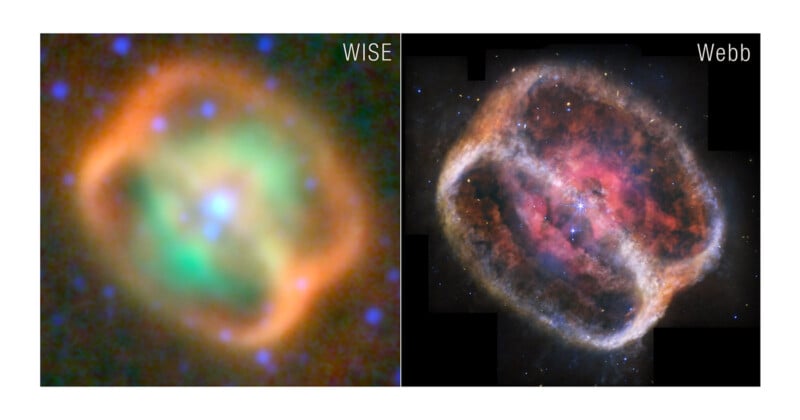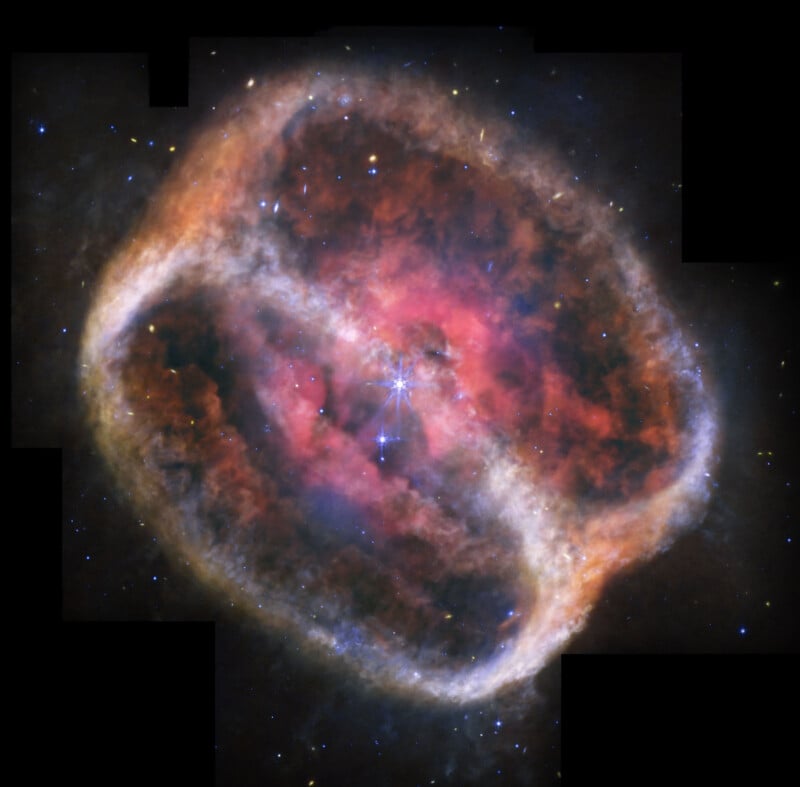Incredible Photo of a Dying Star Shows How Far Telescopes Have Come

The James Webb Space Telescope’s (JWST) new mid-infrared image of the planetary nebula NGC 1514, which shows a dying heart at its center ejecting vast quantities of gas and dust, is spectacular in itself. It’s also an incredible example of how far space telescope imaging technology has come compared to the same object imaged by NASA’s Wide-field Infrared Survey Explorer (WISE) in 2010.
What makes Webb so great at capturing NGC 1514 in remarkable detail is its mid-infrared imaging capabilities. While JWST has numerous camera systems onboard, its Mid-Infrared Instrument (MIRI) is especially excellent at bringing gas and dust into focus. Studying this gas and dust, which is being ejected by the dying star at the heart of NGC 1514, will help scientists understand more about nebulae. And, of course, studying nebulae requires sharp, detailed images.
“Before Webb, we weren’t able to detect most of this material, let alone observe it so clearly,” says Mike Ressler, researcher and project scientist for Webb’s MIRI at NASA’s Jet Propulsion Laboratory in California. “With MIRI’s data, we can now comprehensively examine the turbulent nature of this nebula.”
Ressler is very familiar with NGC 1514, as he discovered the rings around it in 2010 when he examined an image captured by NASA’s WISE. Compared to the image WISE captured in 2010, the improvement in resolution and detail is remarkable — it is a truly generational leap in photographic capabilities. Thanks to this jump, which is best measured in metaphorical light-years, scientists like Ressler can learn much more about NGC 1514 and other nebulae.
As NASA explains, this particular, violent scene of a dying star has been forming “for at least 4,000 years,” and will continually evolve for thousands of years more. While that is a very long time on a human timescale, it is an exceptionally rapid process in terms of the Universe.
It may look like there is only one super bright central star, but there are actually two. The lower-left star visible in the Webb image is not part of NGC 1514 but is located much closer to Earth. The central binary stars follow a “tight, elongated” nine-year orbital period and are enveloped by a layer of dust, which is shown as orange in Webb’s new shot.

One of these stars, once several times more massive than the Sun, is the lead actor in the cosmic destruction.
“As it evolved, it puffed up, throwing off layers of gas and dust in in a very slow, dense stellar wind,” explains David Jones, senior scientist at the Institute of Astrophysics on the Canary Islands. Jones proved NGC 1514 has a binary star system at its center in 2017.
Once these outer layers were fired off into space, only the super hot, compact core remained behind. The now white dwarf star has ever-changing winds, which may have “swept up material into thin shells.”
Webb’s observations show the nebula tilted at a 60-degree angle, “which makes it look like a can is being poured,” as NASA puts it. However, scientists believe it is more likely that NGC 1514 is shaped like an hourglass with “the ends lopped off.” There is a slightly pinched waist near the top left and bottom right corners of the image, where the dust is more orange and forms a shallow V-shape.
As for why these contours exist, Jones describes a leading theory: “When this star was at its peak of losing material, the companion could have gotten very, very close. That interaction can lead to shapes that you wouldn’t expect. Instead of producing a sphere, this interaction might have formed these rings.”
Beyond the dust, which Ressler says is made up of “very small dust grains” that are illuminated by ultraviolet light emitted by the white dwarf star, Webb’s observations also revealed oxygen, shown as the clumpy pink center of NGC 1514.
While it is fascinating to see what is present, NGC 1514 is also notable for what it lacks. Carbon, both simple and complex forms like polycyclic aromatic hydrocarbons, are prevalent in planetary nebulae. However, neither has been detected in NGC 1514. Perhaps complex molecules have not yet had time to form.
It’s not a bad thing in terms of visual splendor, though, as the simpler composition of materials in NGC 1514 means that light from both binary stars at its center can extend much farther, enabling Webb to see the faint, cloud-like rings.
Image credits: NASA, ESA, CSA, STScI, NASA-JPL, Caltech, UCLA, Michael Ressler (NASA-JPL), Dave Jones (IAC)